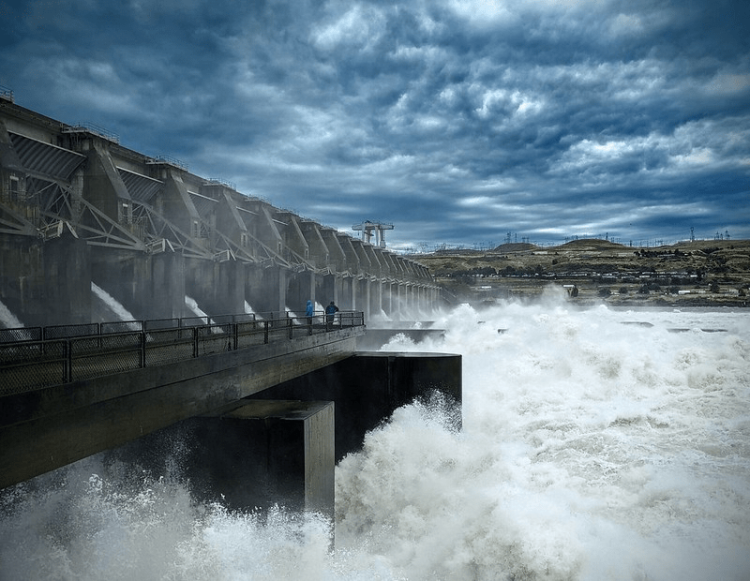In 1880, the country's first hydroelectric power plant revved to life in Grand Rapids, Michigan, and lit up 16 lamps at the Wolverine Chair Factory plus lighting for a theatre and storefront downtown.
Today, nearly 150 years later, close to 2,300 hydropower plants are generating renewable, affordable energy across the United States. While these facilities offer many local benefits, like drinking water, recreation, and backup power to reboot the grid after a blackout, they're also key to achieving the nation's goal of transitioning to a clean electricity system by 2035.
Many of the hydropower facilities operating today are more than 50 or even 100 years old, and a lot has changed since they were built.

The Dalles Dam Spillway on the Columbia River in Oregon // Photo taken by taken by Garrett Hall, Mechanical Engineer for the U.S. Army Corps of Engineers, and released by Amber Tilton, U.S. Army Corps of Engineers
Today's hydropower plants can benefit from modern technologies, including physical upgrades like more efficient generators or more fish friendly turbines as well as new digital tools to control power production. And as more hydropower owners and operators opt for digital controls, they can also benefit from new ways to secure their plants against the rising threat of cyberattacks. That's why the U.S. Department of Energy's (DOE's) Water Power Technologies Office (WPTO) supports research and development efforts that can help plant owners and operators modernize U.S. hydropower facilities.
But what does this work actually look like? Here are some answers to questions about hydropower modernization.

Natel's research engineer Simone Lassar pauses while working with other Natel personnel and a crane operator to install a new test turbine in Natel's closed hydraulic loop facility in preparation for fish passage testing.
What Does Hydropower Modernization Mean?
Hydropower modernization refers to efforts to strengthen U.S. hydropower facilities through technology upgrades. These upgrades can include:
- Repairing, replacing, and stabilizing outdated physical components, like turbines, rotors, and dams.
- Adding digital controls to enable hydropower facilities to respond to electricity demands faster and with greater precision.
- Securing facilities against cyberattacks.
These upgrades could help U.S. hydropower facilities operate safely and efficiently to provide more renewable energy to the U.S. power grid. Further, as the grid evolves to incorporate more variable renewable energy sources like wind energy and solar power, hydropower will play a key role in ensuring the grid remains reliable and stable.
What Are Some Examples of Modern Hydropower Technologies?
Today, the hydropower industry is adopting new technologies, including low-impact ones, that can help reduce facilities' environmental effects and offer additional benefits. This includes:
- New fish-friendly turbines that allow more than 99% of fish to safely pass through facilities.
- Environmental monitoring technologies that can improve the accuracy of detecting fish near hydropower facilities.
- Opportunities to adopt advanced materials and manufacturing, which could lower operation costs and increase the efficiency of the country's existing and future hydropower facilities.
What Hydropower Innovations Could Increase Hydropower Capacity?
To add more hydropower to the U.S. power grid, researchers are finding state-of-the-art ways to increase hydropower capacity. For example, less than 3% of the country's more than 90,000 dams generate hydropower. Adding power-generating infrastructure to these non-powered dams could significantly increase the country's hydropower capacity without the need to build new dams.
Existing hydropower facilities can also increase capacities through unit additions and refurbishments or replacements. Further, at least 11 hydropower plants in the United States have added or are planning to add battery storage capacity to their facilities, a promising trend for hydropower in the future.
Researchers are also exploring how to add hydropower to existing pipelines, irrigation canals, and other waterways another example of low-impact hydropower, or hydropower facilities that help protect and preserve the environment.
Why Is Cybersecurity Important for Modern Hydropower Facilities?
Today's grid uses smart, digital technologies to operate more efficiently. But that means the grid and hydropower facilities must also prepare for an increased risk of cyberattacks. Facility owners and operators can use tools, like a cybersecurity risk assessment tool, to understand their risk and invest in cybersecurity, if warranted.

Workers at Bowersock hydropower plant in Lawrence, Kansas. Image from Dan Hughes
How Is DOE Supporting Hydropower Modernization?
If hydropower facilities cannot afford to perform critical maintenance, some may be forced to close.
WPTO and other offices across DOE support the development of new digital technologies that can enable hydropower owners and operators to model their facilities and explore potential improvements in a low-risk, low-cost, virtual environment. These virtual replicas can help hydropower owners decide which technology improvements could have the greatest impact on their energy production, costs, and more.
Through the Bipartisan Infrastructure Law, Congress allocated funding to DOE for three Hydroelectric Incentives. Led by DOE's Grid Deployment Office, these incentives support eligible hydropower facilities to maintain and enhance their technology, improve dam safety, and reduce environmental impacts. For example, the Bowersock Mills & Power Company, a low-impact hydropower facility operating on the Kansas River, cited the incentives as a primary reason why the facility can continue to provide clean energy and good-paying jobs to Kansans. GDO recently issued application guidance and opened the application period for the Hydroelectric Production Incentives covering electricity generated and sold in calendar year 2023. Applications are due by 5 p.m. ET on April 23, 2024.
Why Should Americans Care About Hydropower Modernization?
Hydropower is already one of the most affordable forms of energy. With modern technologies and innovations, these facilities could produce far more energy, more efficiently and for lower overall costs.
Modern hydropower solutions will also help protect the environment and future clean energy grid. Today's modernized facilities can provide more safe, reliable, and resilient energy to the country's power grid, supporting American communities for generations and centuries to come.










